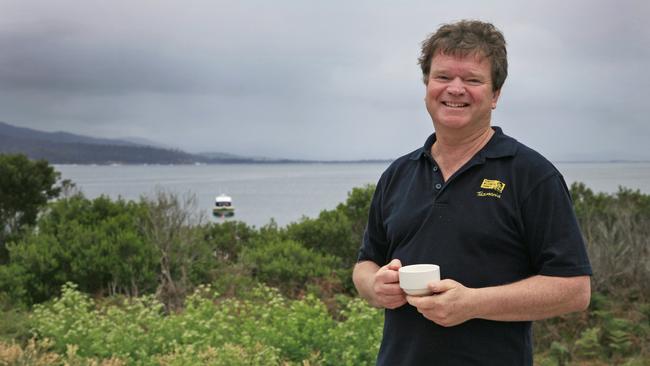Cafe Society: Niche dreams seduce seafarer
Rob Pennicott sees huge opportunity for the next generation in tourism

Tasmania
Don't miss out on the headlines from Tasmania. Followed categories will be added to My News.
ECO-cruises king Rob Pennicott won Australia’s best new tourism development with his seafood tour in 2014, but recently it made an even bigger splash.
On October 26, Pennicott received a text saying “read this” with a link to a review published in The Australian.
The food critic was John Lethlean, who reviewed a Hobart seafood restaurant so scathingly three years ago that it made our news pages.
When Pennicott read what Lethlean had written about his Seafood Seduction tour, the Tasmanian mariner was brought to tears.
“I wondered if he’d had too much to drink,” he says when we meet on a rainy Sunday at the Bruny Island Cruises’ visitor centre and restaurant at Adventure Bay.
He laughs.
“I know John Lethlean says what he thinks, so when I read it I had a bit of a tear and a bit of a shaky voice.”
MORE CAFE SOCIETY:
ROSALIE MARTIN: INSPIRING HIGH HOPES FOR OUR STATE
SCOTT RANKIN: FORGING JUSTICE THROUGH ART
REG GRUNDY: HELPING TOURISTS GO WILD IN WILDERNESS
EMILY SHEPHERD: NURSES BEING PUSHED TO THE LIMIT
YVETTE BREYTENBACH: IS HOBART GETTING TOO BORING?
It turns out Pennicott’s team utterly seduced the reviewer, who told readers he had just discovered that the best restaurant in Australia was on a boat.
“Is there a heaven?” Lethlean concluded after a day cruising the D’Entrecasteaux Channel and Bruny waters aboard Pennicott’s Sea Dragon, a 12m rigid inflatable.
“I’d like to think so. Simply the best.”
As part of the day-long experience for a maximum of 12 guests, skipper Kate Wilson and her crew harvested a sea feast, diving for abalone and urchin, and prepared it onboard for guests.
Pennicott sees plenty of scope for new niche tourism products attracting the same band of clientele.
“Over the next 10 to 20 years there are huge opportunities for small, high-end, authentic Tasmanian experiences,” he says.
“More products done with higher yield – rather than higher volume – is what Tasmania should be looking for in expanding.
“My products fit that, but alone they would not be very influential. Doing it collectively, with a lot of us doing a really good job on niche products, is what makes tourism in Tasmania so great.”
Pennicott, who launched his cruises off Bruny Island nearly 20 years ago and has won a swag of national awards, is content with the industry’s 2 per cent annual growth rate.
“That’s really sustainable,” he says. “I would like to see that yield continuing to rise, with the visitation number only having a very small increase. I think the general community of Tasmania feels the same way.”
He says the restricted access and ferry fare to Bruny Island cap low-yield visitation to the island, where infrastructure is limited.
“If we look at the bigger picture and the water between Melbourne and Hobart, it keeps away huge numbers of low yield. And the Bruny Island ferry does the same thing for budget-conscious travellers.”
While that filter has advantages, there’s a downside, too.
Pennicott expressed concern mid-year when a ferry contract was awarded to a rival tender, saying his tourism business risked losing millions of dollars this summer if the ferry could not reliably deliver his clients.
He says he has since established a constructive dialogue with the new operator, SeaLink, saying it is doing its best to keep up with capacity. He is hopeful that when its second new ferry is built, it will be larger than the first now under way.
The former commercial fisherman is also keeping a close eye on developments relating to the expansion of salmon farms around Storm Bay off North Bruny.
“I am not against fish farming, but I just want to see it growing the right way, which is not necessarily bigger is better.”
He thinks positioning farms 3-4km offshore would be an appropriate distance to minimise impact to other marine users and the broader community.
So much relating to tourism development rests on scale, yield and site appropriateness, he says.
He is comfortable with the idea of sustainable tourism growth in national parks, including in the Tasmanian Wilderness World Heritage Area. “I think if they are small, sensitive, environmentally approved developments, it is OK.”
He’s feeling jittery about cruise ships, though, calling for a cap on Hobart visitation and bans in some places.
“I am so opposed to large cruise ships coming into Adventure Bay,” he says.
“Smaller ones are manageable. But one person over 200, I oppose, big time.”
His advice to Tassie’s future tourism entrepreneurs is to find mentors; follow passions; get started rather than getting blocked by setting first goals too high; and refuse to give in to fear at the first challenge.
“Nearly everything I do, people tell me I shouldn’t,” he says. “I feel the fear but I push through to the creative side. Whatever new you do, you will need to fine tune.”
Pennicott is set to launch beyond Tasmania in February, with amphibious boat tours at Wilsons Promontory National Park in Victoria.
“You want to talk about fear?” he laughs. “I am in the fear stage now.”


